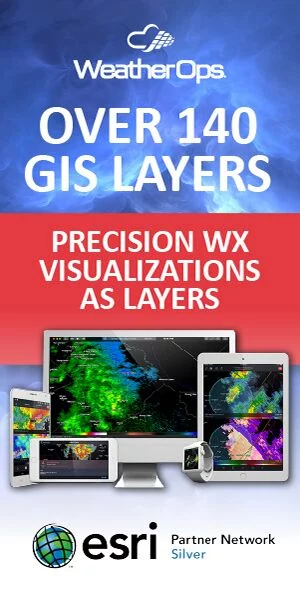Doppler radars work by bouncing radio waves off particles in the air. Those particles could be raindrops, hail, snow, or even dust and insects. The amount of energy that bounces off of those particles and returns to the radar is called “reflectivity” and is represented by the variable “Z.” Reflectivity covers a wide range of signal strength, from very weak to very strong, so it is measured on a decibel (logarithmic) scale in units of dBZ or decibels of Z. The higher the dBZ value, the larger the number or size of the particles the radar beam is seeing.
The dBZ values increase as the strength of the signal returned to the radar increases. The scale of dBZ values is related to the intensity of rainfall. It is important to remember, however, that the radar shows only areas of returned energy and not necessarily precipitation. So the presence of a return, especially a very weak return below 20 dBZ, doesn’t always mean that it’s raining.
The colors along the bottom of the map correspond to precipitation types and intensities. When you move your cursor across the squares, RadarScope will display a value for each color. NEXRAD radars can’t distinguish between different kinds of precipitation with absolute certainty. However, reflectivity values can be somewhat roughly associated with varying types of precipitation:
- 10 dBZ (blue) – Very light rain or light snow
- 20 dBZ (green) – Light rain or moderate to heavy snow
- 30 dBZ (yellow) – Moderate rain or sleet showers
- 40 dBZ (orange) – Moderate to heavy rain or sleet showers
- 50 dBZ (red) – Heavy thunderstorms
- 60 dBZ (pink) – Intense to severe thunderstorms with hail
Like in the movie “Pirates of the Caribbean,” these reflectivity values are more like guidelines than rules. The atmosphere is a complex system, so you can’t always associate particular values with precise conditions or events. In general, the higher the dBZ value, the heavier the concentration of objects at that location in the atmosphere.
RadarScope provides the following reflectivity products for NEXRAD radars:
Super-Res Reflectivity
The default product in RadarScope is super-res reflectivity. At 0.25 kilometers by 0.5 degrees, it gives the highest-resolution reflectivity available from NEXRAD radars to a distance of 230 kilometers from the radar. Super-res reflectivity is available at four different tilts or beam angles, with tilt 1 being the lowest to ground level.
Base Reflectivity
Base reflectivity is the standard reflectivity product distributed in the NEXRAD Level III product suite. It’s the same data as super-res reflectivity but at a lower resolution and more extensive coverage area.
Precipitation Depiction
Precipitation Depiction is a proprietary WDT product combining super-res reflectivity data and surface observations to show a depiction of the current hydrometeor type. Rain is displayed using a somewhat traditional color palette for reflectivity, snow presented in shades of blue, and wintery mix is shown in shades of red. The determination of rain, mix, or snow is an approximation based on multiple data sources and subject to error.
Composite Reflectivity
Composite Reflectivity combines data from all elevation scans or tilts, to create a single product. The resulting image shows the highest reflectivity value from the vertical cross section at that location. Composite Reflectivity can reveal essential features in a storm’s structure that might not be seen in the base reflectivity product.
Because it combines data from all the tilts, the composite reflectivity product is one of the last to be produced during a volume scan. As with all NEXRAD products, it’s important to remember that the data displayed in the image depict conditions that have already happened rather than what is happening right now.
Learn More
You can learn more about reflectivity products through these resources:






